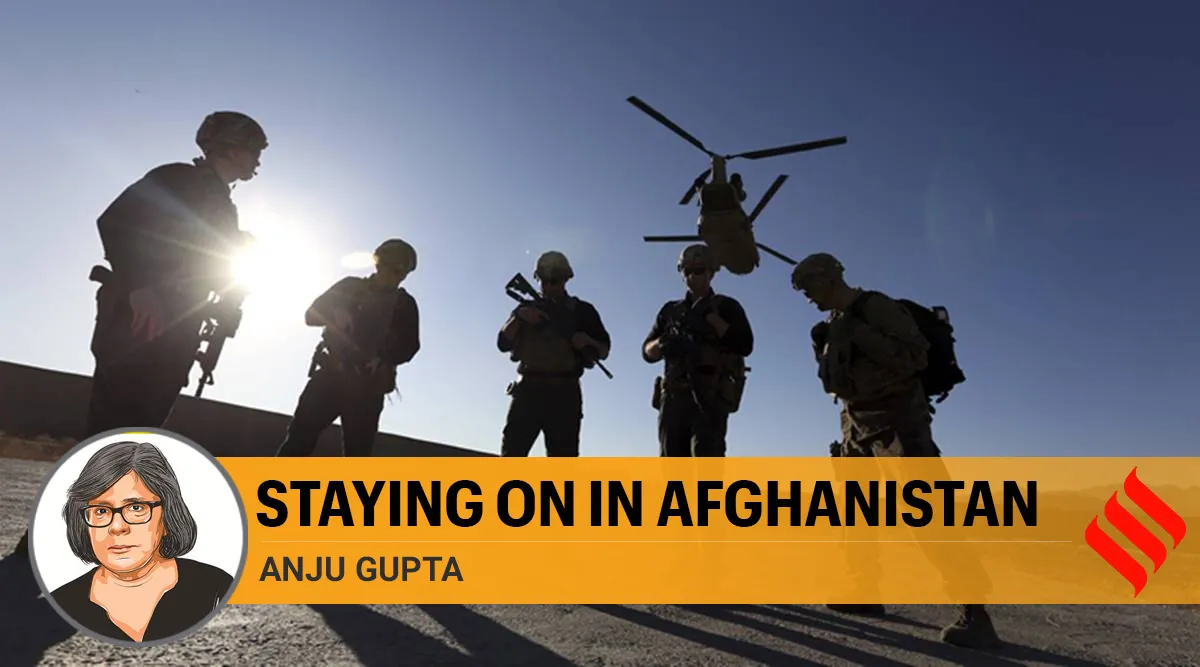 FILE - In this file photo, American soldiers wait on the tarmac in Logar province, Afghanistan. (AP Photo/Rahmat Gul, File)
FILE - In this file photo, American soldiers wait on the tarmac in Logar province, Afghanistan. (AP Photo/Rahmat Gul, File)In 1979, Afghanistan became a theatre of the Cold War. In later years, the land used for “jihad” against “godless” Soviets by the US-Saudi-Pakistan axis was converted into a hub for al Qaeda’s terror network. The al Qaeda trained future jihadis of Afghanistan-Pakistan and thousands of foreign fighters. Following the 9/11 attacks, the US targeted the Taliban, which receded into sanctuaries in Pakistan. Despite efforts by the international and Afghan communities, Afghanistan continues to bleed from attacks by the Taliban-al Qaeda network. The Intra-Afghan talks began on September 12. Many believe that the US will “exit” this time. However, closer scrutiny suggests that an exit is unlikely, irrespective of the results of the US presidential elections. The network will continue to pose serious threats to Indian and global security.
Like much of the world, India too did not recognise the Taliban government (1996-2001). In December 1999, five Pakistanis from JeM (Jaish e Mohammad) hijacked Indian Airlines passenger flight IC 814, on route to Delhi from Kathmandu, and landed in Kandahar. Passengers were “swapped” for prisoners in Indian jails. The hijacking showed how Pakistan was using Afghanistan to perpetrate international terrorism.
In August 1998, al Qaeda’s operatives bombed US embassies in Kenya and Tanzania. The US mounted strikes against al Qaeda’s training camps in the Haqqani area in Afghanistan. In 2000, al Qaeda’s suicide bombers hit the USS Cole in Yemen. 9/11 got the US to go after the network. From the safe havens of Pakistan, Taliban supremo Mullah Omar refused to hand over Osama Bin Laden, who was killed in a May 2011 raid by US SEALs in his home — a few kilometres from the Pakistan Military Academy.
Due to the West’s pre-occupation with “other wars”, by 2008, the network had regained control over large swathes of rural Afghanistan and was repeatedly targeting provincial capitals. In December 2009, Barack Obama announced a “troops surge and withdrawal” to turn the tide. The surge to over 1,40,000 troops (including allies) helped build Afghan forces against the network. At the end of its term, the troops level was down to 8,600 plus the counter-terrorism component. By November 2017, under President Donald Trump, US troops rose to 14,000, now down to 8,600 plus the counter-terrorism component.
The Afghan peace process hinges on the US securing its counter-terrorism interests and the Taliban and the government charting a roadmap to peace. The US-Taliban agreement stipulates an exit before May 2021, if conditions are met.
The “surge and withdrawal” has evolved as a favoured US strategy in Afghanistan, Iraq and Syria. The strategy entails identifying and empowering a local ally against common enemies. It leads to adjusting the “US force posturing” to ensure that the local ally is not defeated. The core interests are guarded while reducing casualties of their own troops. Different US presidents have couched the strategy in different political terms. This is unlikely to change post-elections.
Unlike in Iraq and Syria, the US has no bases in Central Asia or South Asia. The presence in Afghanistan, critical for counterterrorism, is also crucial for geopolitical imperatives. With China in Gwadar and a hostile Iran, a credible presence is needed to secure much more than the safety of the Embassy.
The US has identified and invested in Afghan forces as a local ally. The tangible dividends are visible in oversight (SIGAR) reports. The US Defence report, July 2020, reiterates that the vital national interest is “to ensure that (Afghanistan) is never again used as a safe haven from which terrorists can attack the US or our allies or interests abroad”. The February 29 US-Afghan joint declaration has committed to “joint assessment and determination” as the basis for an exit.
Without a ceasefire, deep mistrust would affect the Intra-Afghan talks. With incentives, a part of the Taliban may compromise. In reality, Intra-Afghan talks are a “mediation” between the Afghan government and the Pakistan Army.
The US strategy has ensured that the network has not overrun governments. Several counter-terrorism targets in Afghanistan-Pakistan have been taken out including top al Qaeda leaders and scores of foreign fighters. The US-Afghan partnership has deterred a “genuine” IS (Islamic State) from taking roots in Afghanistan.
The threats from the network remain. A UN Report in July stresses that al Qaeda is covertly active in 12 provinces and the al Qaeda chief, Ayman al-Zawahiri, is in Afghanistan. It estimates al Qaeda cadres to be between 400 and 600 and having top-level contacts with the Haqqani network. The report mentions that foreign fighters from Pakistan, India, Bangladesh and Myanmar are present within AQIS (al Qaeda in Indian Subcontinent).
Pakistan is backing the network for its own interest. The network has long taken control of ISKP (IS in Khurasan Province). The shadow boxing of the Taliban with ISKP projects it as a key “ally against IS”. Several arrests in India and Afghanistan show how AQIS and ISKP are recruiting online and inciting lone wolf attacks across South Asia. The Afghanistan-Pakistan based network will continue to impact the security of India and the West in South Asia and beyond.
This article first appeared in the print edition on September 24, 2020 under the title ‘Staying on in Afghanistan’ The writer is an IPS officer. Views are personal
📣 The Indian Express is now on Telegram. Click here to join our channel (@indianexpress) and stay updated with the latest headlines
For all the latest Opinion News, download Indian Express App.